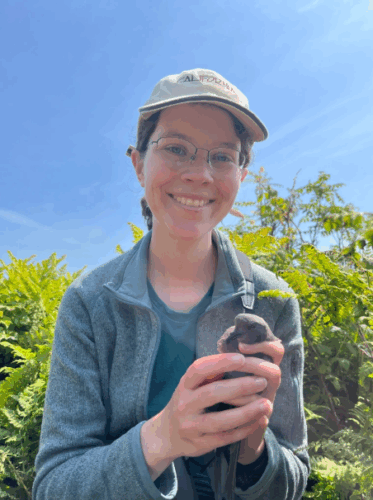During the pandemic, Molly Hill (YC ’25) spent much of her time thinking about birds. Growing up in Pasadena, a suburb northeast of downtown Los Angeles, Hill didn’t have easy access to abundant natural spaces. “When I visited family in Michigan, I really loved how much nature there was,” Hill recalled. “In Pasadena, in the city, there wasn’t as much nature as I wanted.”
Still, Pasadena—and the Greater Los Angeles Area—is home to a surprising number of nonnative species of birds, often descended from escaped pets or introduced populations. During the COVID-19 pandemic, Hill began observing Indian peafowl, or peacocks, as part of an independent research project with the American Birding Association. What began as curiosity soon turned into a passion. Hill joined the Moore Lab of Zoology at Occidental College, where she helped demonstrate that one subspecies of the azure-hooded jay, a vibrant Central American bird, should be recognized as a distinct species.
Now a senior at Yale, Hill has already made an impressive mark in ornithology. She is a 2024 Barry Goldwater Scholar, a selective award given to undergraduates pursuing research careers in the sciences, engineering, or mathematics. At Yale, she joined the lab of professor Richard Prum, where she investigated the shimmering iridescence of birds by examining hundreds of museum specimens at the Peabody Museum of Natural History and the American Museum of Natural History in New York.
But Hill was drawn to another mystery in the bird world: why do some species take years to reach full adult plumage? Most songbirds mature in just one year, but others—especially colonial seabirds—don’t. To investigate, Hill spent time at the Bowdoin Scientific Station on Kent Island in New Brunswick, Canada. Her research team placed plastic models of gulls at different maturity stages—young immature, adult immature, and breeding adult—near a nesting colony to observe how adult gulls reacted.
Her preliminary results showed that gulls were more aggressive toward adult-resembling models than younger-looking ones. Hill’s findings suggest that delayed plumage maturation may offer a survival advantage. “They don’t breed, but they are able to learn how to be a colonial bird without getting beat up,” Hill said. This pattern is also seen in other colonial seabirds—such as albatrosses, gannets, and loons—which return to communal nesting sites before reaching breeding age, allowing them to develop social and colonial skills.
At Yale, Hill is double majoring in Ecology and Evolutionary Biology (EEB) and the Humanities and has found her place in both scientific and creative communities. She joined the Yale EEB Undergraduate Group and helped revive the Yale Birding Student Association in 2024, serving as an officer. She also served as Editor-in-Chief of The Environmentalist, a magazine under the Yale Student Environmental Coalition that features poetry, essays, and stories focused on environmental advocacy. “It feels important to not just do research about birds but share that research with other people and, overall, raise awareness for bird conservation,” Hill said.
For her EEB senior thesis, Hill returned home to study Los Angeles’ wild parrot populations—specifically red-crowned and lilac-crowned amazons, rumored to have originated after a pet store fire. Fascinated by their vocalizations, Hill has been studying how the urban environment affects communication of these highly intelligent social animals. “I actually wrote an essay about the LA parrots for The Environmentalist,” she said. “Unlike invasive species, the parrots don’t seem to be competing with native species or hurting the native ecosystem. They’ve established a new niche for themselves utilizing other non-native food sources like ornamental fruit trees. ” Meanwhile, her humanities thesis explores animal behavior through a series of essays—blending her own fieldwork with reflections on the broader world of zoological research.
Although she doesn’t yet know where she’ll be in the next five years, Hill is certain birds will still be a constant in her life. She’s especially drawn to questions about animal communication, cognition, and behavior, and envisions herself doing fieldwork, teaching, or working with a conservation nonprofit or the US Fish and Wildlife Service.
Her next endeavor takes her to the forests of New Zealand, where she will be studying the kea, a large parrot native to the island country. “They’re really cool and intelligent,” Hill said. Continuing her work on gull plumage maturation, Hill is eager to see how far she can soar.

